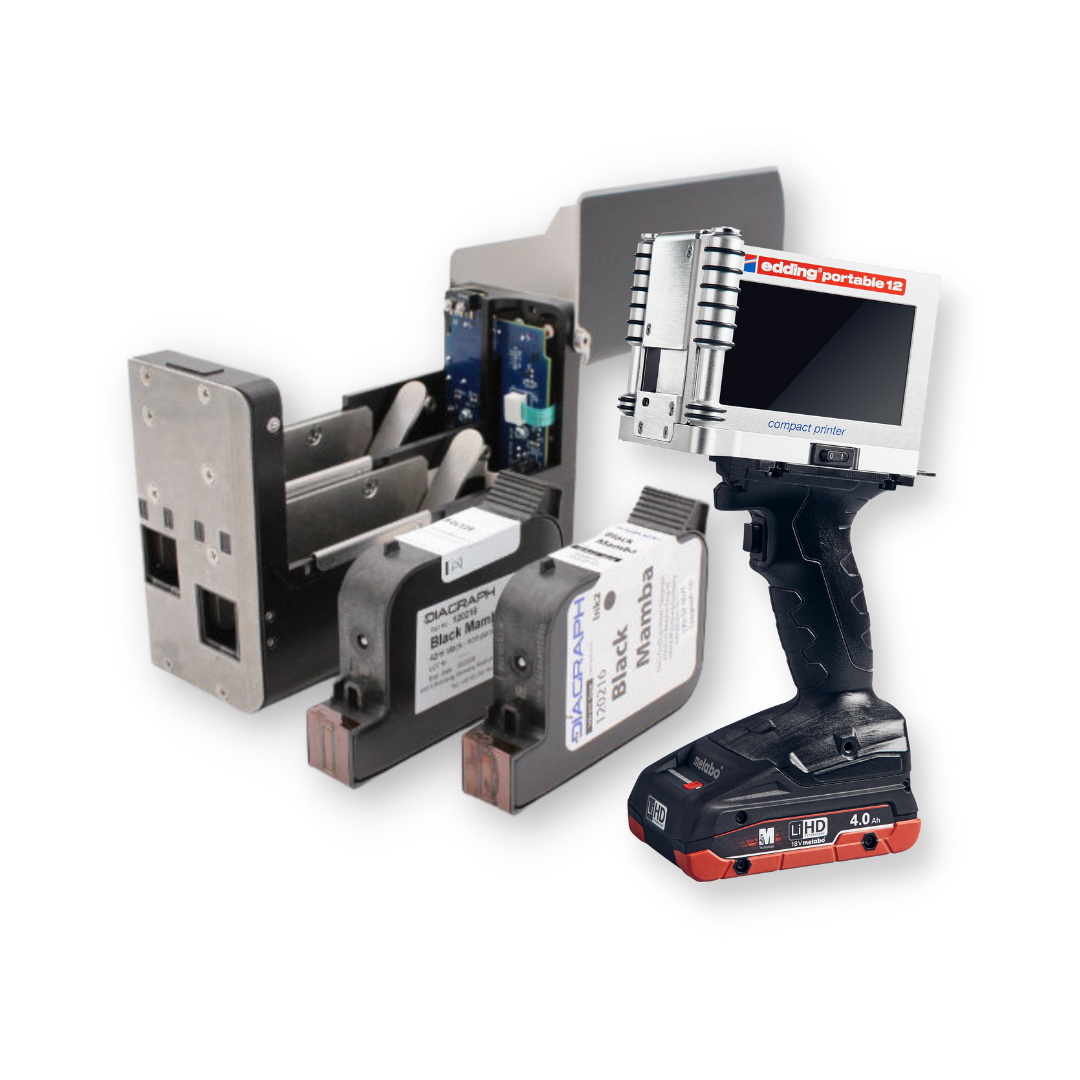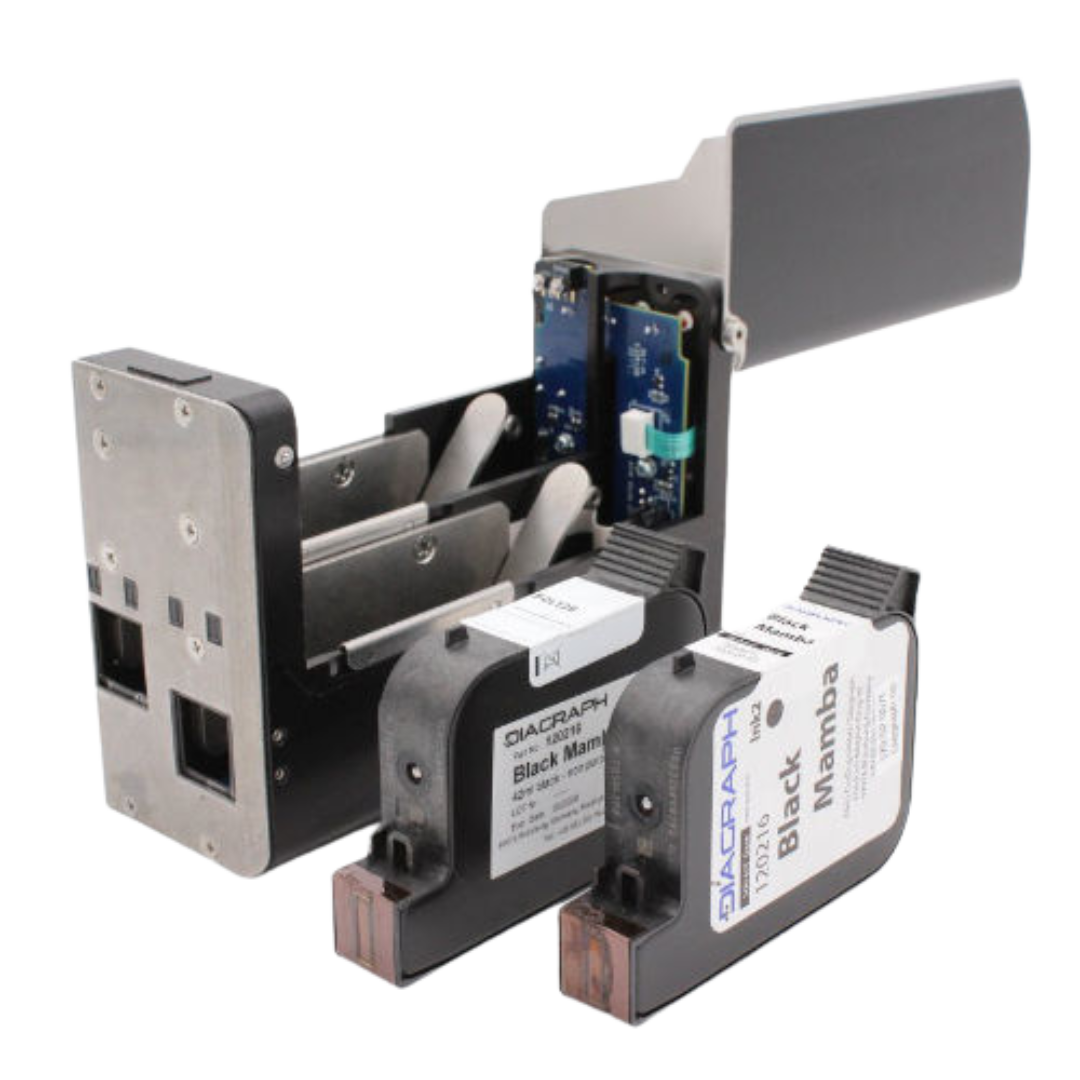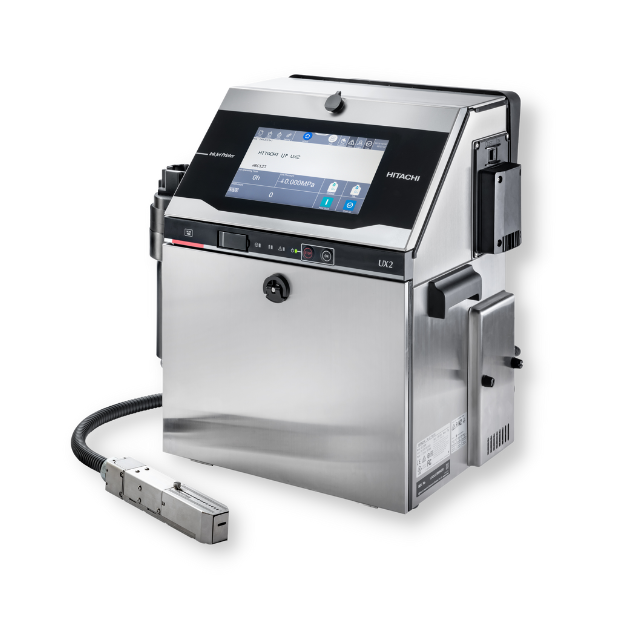Start or upgrade a production
line in 55 seconds.
Thermal Inkjet Printing systems from i-mark are the most flexible in the market and indeed within the Marking and Coding global family. With its exceptionally low-budget entry for the printer, delivering hi-resolution barcodes. Being able to print onto non-porous surfaces such as Glass Bottles, cables or automobile components, makes this the printer of choice for many manufacturers. Boasting a range of quick change coloured ink options, with exceptionally quick drying times and the ability to use either integrated online, with print heights ranging from 12mm to 100mm, or as a stand-alone hand printer, makes i-marks Thermal Injet the most versatile in the industry.

The Diagraph TJ500/TJ1000 Thermal Inkjet Printers are robust, high-performance printing solutions designed to meet the demanding needs of industrial environments. These printers embody the cutting edge of thermal inkjet technology, offering unparalleled precision and reliability for high-speed marking and coding applications. With the option to introduce a single head 12.5mm print height to multiple heads providing up to 100mm, in a variety of colours, including black , of course!

The Handheld Thermal Inkjet Printer represents a pinnacle of convenience and efficiency in the world of portable printing technology. Designed for versatility and ease of use, this compact device offers the ability to print high-quality, precise markings on a variety of surfaces, ranging from paper and cardboard to metal and plastic. It harnesses the power of thermal inkjet technology to deliver crisp, clear text, barcodes, and logos with remarkable accuracy and speed.
Thermal Inkjet Printers

Thermal inkjet printing operates on a principle that seems almost simple in its elegance but is complex in its execution. At its core, the technology uses heat to create a bubble in an ink reservoir, which propels a droplet of ink out of a nozzle and onto the paper or material. This process begins when an electrical current heats a tiny resistor within the print head. As the ink in contact with this resistor rapidly heats up, it expands and forms a bubble. This expansion forces a droplet of ink out of the nozzle at high speed. Once the droplet is ejected, the bubble collapses, creating a vacuum that draws more ink into the chamber from the cartridge, readying it for the next print action. This cycle can repeat thousands of times per second, allowing for fast and precise printing.
Thermal inkjet printers offer several advantages over other printing technologies, making them a compelling choice for a variety of users:
Ease of
Integration
Thermal inkjet printers can be easily integrated into existing manufacturing processes, with minimal disruption. They are compact and can be installed in various orientations, accommodating space constraints and specific line configurations.
Multiple Coloured
Ink Options
i-mark's versatile inks allow a multitude of differing colours of ink to be used and easily swapped from one colour to another on demand. This is all in addition to being able to have coloured food-grade inks as an option.
Versatility in
Materials
These printers can mark and code on a wide variety of substrates, including paper, plastics, metals, and even glass, without requiring direct contact. This flexibility is invaluable for businesses that work with diverse packaging materials.
Fast Drying
Times
The inks used in thermal inkjet printers dry quickly, which is crucial for maintaining high-speed production lines. Fast drying reduces the risk of smudging and allows for immediate handling or packaging of the marked items.
High-Resolution
Printing
Thermal inkjet printers offer superior print quality, producing crisp, clear, and easily readable markings and codes. This is essential for applications requiring detailed graphics, barcodes, or QR codes.
Low
Maintenance
With fewer moving parts and no need for contact with the substrate, thermal inkjet printers require less maintenance compared to other marking technologies. This minimises downtime and maintenance costs.
Cost-Effective for
Small to Medium Runs:
For businesses with variable printing needs or smaller production runs, thermal inkjet printers offer a cost-effective solution due to their low initial investment and operational costs.
The thermal inkjet printing process operates through a precise mechanism where ink cartridges within the printer heat the ink to temperatures up to 300°C. This intense heat causes the ink to boil and form a vapour bubble, expanding its volume. The formation of this bubble generates pressure that propels ink droplets out of the nozzle with high accuracy onto the substrate. Once the ink droplets make contact, they cool rapidly, returning to a liquid state and creating sharp, detailed prints. As the vapour bubble collapses, a vacuum is created, drawing new ink into the nozzle for the next droplet ejection. This cycle allows for fast, efficient printing without compromising on quality.



Principle: DOD technology operates by ejecting ink droplets from the print nozzle only when required. The ink resides in a chamber behind the nozzle, with the ejection controlled by varying the pressure within this chamber. This method ensures that only the necessary amount of ink is used for each print. DOD is further categorised into Piezo Inkjet (PIJ) and Thermal Inkjet (TIJ) based on the mechanism used to create pressure changes.
Piezo Inkjet (PIJ): Utilises a piezoelectric material that changes shape or size when an electric charge is applied, generating pressure that forces ink droplets out of the nozzle.
Thermal Inkjet (TIJ): Generates pressure by rapidly heating the ink to create a vapour bubble, as previously described, which ejects ink droplets onto the substrate.
Applications: DOD is particularly suitable for applications where precision and variability of the print are important. It is used in both industrial settings for packaging and labeling, and in consumer printers for documents and photographs. TIJ, with its high-resolution capabilities, is ideal for detailed graphics and text, while PIJ's versatility makes it suitable for a broad range of materials and environments.


Principle: CIJ technology works by propelling a continuous stream of ink droplets through a print nozzle. This stream passes through a charging electrode, where individual droplets are charged according to the printing requirements. As these charged droplets move past a deflection electrode, they are directed onto the substrate to form the desired image or text. Droplets not used for printing are captured and recycled back into the system.
Applications: CIJ is favoured in environments requiring high-speed printing and is commonly used for marking and coding products in industries such as food and beverage, pharmaceuticals, and cosmetics. Its ability to print on uneven or irregular surfaces and a wide range of materials makes it versatile.
Elevate Your Printing Technologies
Unlock the potential of modern printing technologies for your industrial applications by reaching out to us today for the TJ500 or TJ1000 thermal inkjet printer. Our team is ready to assist you and will respond promptly to ensure you receive the information and support you need in the shortest possible time. Elevate your printing processes with our advanced solutions tailored to meet your specific needs. Contact us now to discover how we can help enhance your operations with our cutting-edge thermal inkjet printers.
FAQ's
Questions we have been asked before about Thermal Inkjet Printers.
Thermal inkjet printers differ primarily in their printing process. They use heat to create a bubble in the ink cartridge that propels ink droplets onto the paper. This method allows for quick and precise printing, making them highly efficient for both home and office environments. In contrast, other printers like laser printers use toner and heat to transfer images onto paper, while piezoelectric inkjet printers utilise electrical charges to eject ink droplets.
To maintain your thermal inkjet printer and ensure its longevity, follow these tips:
While thermal inkjet printers are incredibly efficient and capable of producing high-quality prints, they are generally better suited for moderate printing volumes. For businesses or situations where high-volume printing is a regular necessity, a laser printer might be more cost-effective and durable for handling large quantities of prints. However, for home users or small offices, thermal inkjet printers offer a great balance of quality, speed, and versatility.
Thermal inkjet printers can be considered environmentally friendly due to their low power consumption and the availability of recyclable cartridges and parts. Many manufacturers also offer recycling programs for used ink cartridges and responsibly source materials to reduce environmental impact. To further minimise your environmental footprint, look for printers that are Energy Star certified and use paper from sustainable sources.
Thermal inkjet printers use dye-based or pigment-based inks, depending on the model and the desired print quality. Dye-based inks are known for their vibrant colours and are ideal for printing photos and images. Pigment-based inks, on the other hand, provide better longevity and are resistant to water and UV light, making them suitable for documents that need to last a long time or for outdoor applications.
Your production
experts are here to help.
End to end coding and handling solutions from primary packaging through to logistics despatch, supported by 7 years warranty with same day service response and same day consumable despatch.